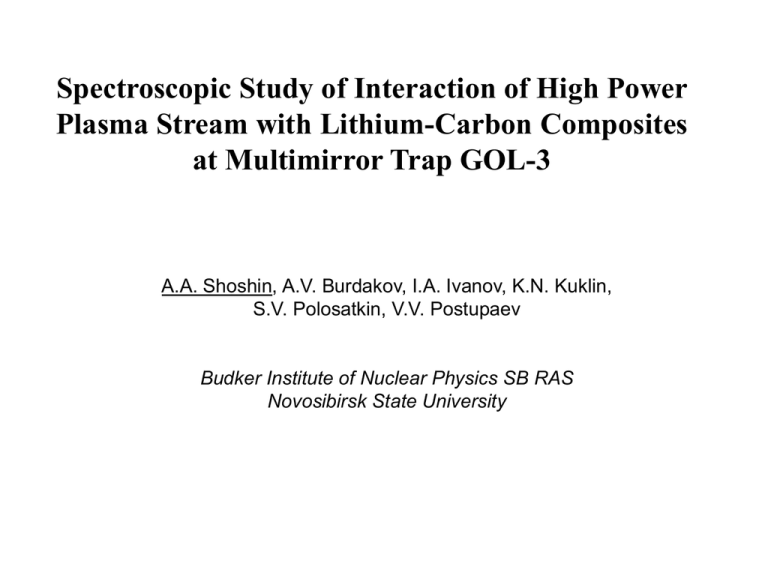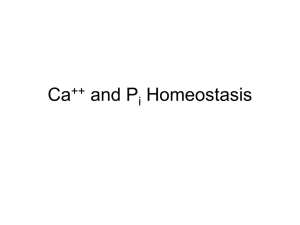PPT
advertisement

Spectroscopic Study of Interaction of High Power Plasma Stream with Lithium-Carbon Composites at Multimirror Trap GOL-3 A.A. Shoshin, A.V. Burdakov, I.A. Ivanov, K.N. Kuklin, S.V. Polosatkin, V.V. Postupaev Budker Institute of Nuclear Physics SB RAS Novosibirsk State University Li in Tokamaks FTU limiter (J. Nucl. Materials 390–391 (2009) 876–885) T11M limiter 2002 Plasma Phys. Control. Fusion 44 955 Li Capillary-Pore System Journal of Nuclear Materials 390–391 (2009) 876–885 CDX-U “Try limiter” (Journal of Nuclear Materials 390–391 (2009) 876–885) Li pellets in NSTX (Journal of Nuclear Materials 363–365 (2007) 791–796) LiD pellets in GOL-3 Li vacuum evaporation in stellarator TJ-II (Journal of Nuclear Materials 390–391 (2009) 852–857) Multimirror trap GOL-3 Electron beam generator U-2 Electron beam • 0.8-1 MeV • 30 kA • 8-12 s • up to 300 kJ Plasma • length ~12 m • 1020- 1022 m-3 • temperature ~1-4 keV • 1 ms Ribbon beam diode with beam compression system Solenoid with corrugated magnetic field Plasma exhaust, materials test station Plasma stream parameters 2 pow er density, M W /cm /keV 100 10 1 Plasma Suprathermal electrons 0 .1 Beam electrons 0 .0 1 0 .1 1 10 energy, keV 100 1000 Energy density in the plasma stream 2 MJ/m2 Main power contained in the energetic (1-10 keV) electrons Specific energy release is below volumetric destruction threshold (10 MJ/m2 ) 1200 J /g 1000 800 600 M e ltin g p o in t (1 8 1 C ) 400 200 0 0 1 2 z ,m m 3 4 5 Calculated energy deposition over depth of lithium under action of electron stream in GOL-3 facility (power density 2 MJ/m2, target inclined at 30º). Horizontal solid and dashed lines correspond to start and end of phase transition, correspondingly. Initially target was at room temperature. Li-graphite phase diagram Physical Rev.B. 2010, v.82, n.12, p.125416 Physical Rev.B. 1984, v.30, n.12, p.7092 Known different binary compounds Li4C, Li6C2, Li8C3, Li6C3, Li4C3, Li4C5 … They are mainly thermodynamically metastable and after heating dissociate to metallic Li and Li2C2 SIBUNIT - SYNTHETIC CARBON MATERIAL Sibunit is a new class of porous carbon-carbon composite materials combining advantages of graphite (chemical stability and electric conductivity) and active coals (high specific surface area and adsorption capacity). Compared to active coals, Sibunit has the following advantages: • high mechanical strength; • chemical and thermal stability; • high purity. Boreskov Institute of Catalysis SB RAS, Novosibirsk Patents were granted in the Russian Federation (1990) and the United States (1992). Sibunit synthesis Li-Sibunit Several lithium-carbon composite samples was made by different methods: 1. Lithium together with graphite or sibunit was heated in argon atmosphere to the temperature 700 ºС. In the experiments these samples were held in special graphite box. 2. Lithium was heated on graphite sample at temperature about 250-300ºС and after melting lithium was smearing for producing homogeneous layer of 0.5 – 1 mm depth. Li film on graphite Layout of target irradiation experiments in the GOL-3 exit unit Target holder Target Diaphragm Plasma stream Vacuum chamber Magnetic coils Optical diagnostics of target plasma Target CCD Plasma Beam Survey spectrometer resolution 0.3 nm range 100 nm High-resolution spectrometer MDR-12 or DFS-24 resolution 0.08 nm 0.005 nm exposure 7-300 microseconds CCD 2D imaging system Plasma radiation in narrow spectral band of graphite target (top) and sibunit-lithium composite in 4cm graphite box (bottom) under action of hot plasma stream moving from the right. 1500 Spectrum of surface plasma produced near lithium-graphite target under action by power plasma stream. In te n s ity , a .u . Li I 1000 H 500 C II Li I C II 0 580 600 620 640 660 680 W a v e le n g h ts , n m One can determine the plasma electron temperature by relation of intensities of lines Li I 610,36 и 670,78 nm. In different shots temperatures varied within 0.7 - 1.2 eV. Temperature of lithium plasma is less than temperature of surface plasma near graphite targets (was measured by ratio of C II lines). It corresponds to smaller first ionization potential and higher transmissibility of lithium with respect to carbon. 2D Spectral selective optical system Object objective lenses CCD камера 1.2 Вт/см2* нм 1 0.8 Narrow band filter Filter transition coefficient Spectrum С2 0.6 0.4 0.2 0 508 510 512 514 wavelength, длина волны, нм nm 516 518 520 Consider a flux of atoms ФA, along a line-of-sight r from surface into a fully ionized plasma. If we assume all the incoming atoms are ionized by electron collisions, between r1 and r2 r2 ФA n A ( r ) n e ( r ) ionization v e dr (1) r1 where nA(r) and ne(r) are the density of atoms and electrons. Ionization rate coefficient <ionization> is a function of the electron temperature Te(r). Electron impact excitation of the atom leads to photon emission with the intensity IA IA hB 4 r2 n A (2) ( r ) n e ( r ) excitation v e dr r1 where <excitation> is the electron impact excitation coefficient for the excitation of the upper level of the radiating state, and B is the branching ratio for the radiative decay which leads to appearance of the observed photons. Equations (1) and (2) give a relation between the particle fluxes and intensities. Provided the rates do not vary much over the observation volume we may write ФA 4 hB IA ionization v e dr excitation v e dr 4 h IA S (3) XB Equation (3) enables conversion of the photon flux ФA (photons/сm2s) into the particle flux. The inverse photon efficiency S/XB is the ratio between ioniSation rate and the product of eXcitation rate and Branching ratio for the observed electronic transition. For 670.8 nm Li I lines S/XB = 1/8.6 was calculated with data from Aladdin database. Estimated atomic lithium flux from the surface was 11020 atoms/(cm2s), it is 3 times smaller with respect to atomic carbon fluxes from graphite targets. Li-Sibunit (carbon) before and after irradiation 5 shots per 2MJ/m2 Li on graphite surface before and after 6 shots per 2 MJ/m2 View of carbon target with lithium films under action of cold plasma in exit unit of GOL-3 facility. Conclusion Several lithium-carbon targets (including Li-Sibunit) were designed, produced and tested under action of plasma stream. Set of diagnostics was developed and used for investigation parameters of surface plasma near targets. It was shown that lithium erosion depth corresponds to melting depth. Temperature of surface plasma about 1 eV was measured. Atomic lithium flux from surface was determined. The flux 1020 atoms/(cm2s) cannot explain the erosion value.






